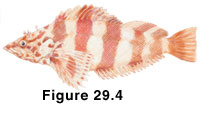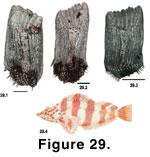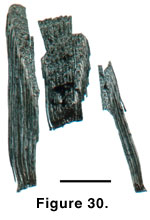 Description
DescriptionOxylebius pictus (Painted
Greenling)
(Other common names: Convict Fish)
Figure 29.4
 Description
DescriptionLength: 25 cm.
Mouth: small, terminal, directed upwards; upper jaw not reaching anterior margin of orbit; thickened lips with upper separated from nasals; teeth fine.
Body: single notched dorsal fin with rayed portion higher than spinous; single notched anal fin; caudal fin rounded; two pairs of erect cirri behind eyes; one lateral line.
Color: gold to tan to grey; five to seven vertical dark red bars that continue through the dorsal and anal fins; three darkened stripes radiating from each eye, one which goes to the snout; dark spots on pectoral, pelvic, and caudal fins.
Depth: 46 m; larvae have been collected in the shallow intertidal zone.
Habitat: intertidal/subtidal rocky substrate; protected reefs.
Season: winter months, variable.
Diet: crustaceans, polychaetes; small molluscs, bryozoans.
Predators: not determined.
Distribution: Baja, California to Aleutian Islands.
 Scale
Description
Scale
DescriptionScale Type: ctenoid on body, except on head to the interorbital region and along the midside where they are cycloid (not shown in figures).
Relative Scale Size: small to moderate.
Position of Scales on Body: 76 scales along the midline (Hart, 1973).
Overall Shape: they are rectangular, elongated in the anterior/posterior axis. One of the lateral fields appears longer then others, but the extent to which this is expressed is variable.
Focus and Circuli: the focus abuts the edge of the posterior field, along the edge of ctenii growth fields and is approximately one third of the total length from the posterior margin. Regeneration appears to be common. The circuli are not continuous between fields. The region of radii formation in the anterior field causes definite disruption of the circuli pattern. Within the anterior field/radii region itself, circuli are difficult to distinguish. Circuli in the lateral fields is well defined. The ridges are quite pronounced and thick.
Radii: numbers are variable and not diagnostic. Present only in the anterior field. The outer edge of the anterior field is slightly scalloped.
 Scale
Preservation
Scale
PreservationOnly limited hexagrammid scale material has been found in our core studies so it is difficult to generalize on their preservation. Although the scales appear to preserve, they are generally not in good condition. They appear to be quite brittle and fragment easily. The posterior field/ctenoid region breaks off, truncating the circuli in the edge of the lateral fields.